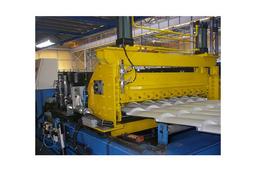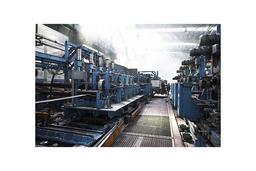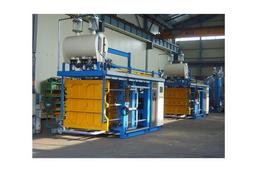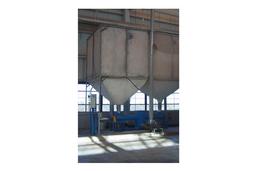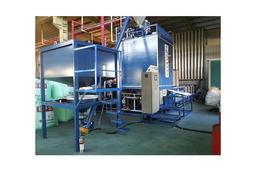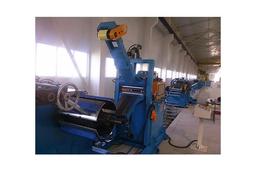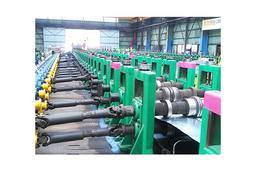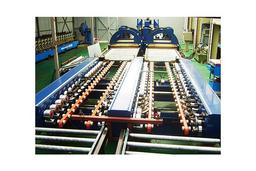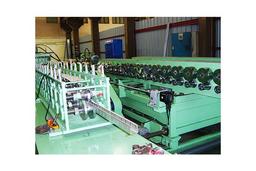



Assembly sandwich panel production line and building material production facility manufacturer
Decoiling system is to feed the color steel sheet (PPGI: Pre-Painted Galvanized Iron) to the sandwich panel production line continuously and it can be manufactured as a cone type and an arm type.
In case of the arm type de-coiling system, a coil car should be included to help the coil setting.
The capacity of decoiler will be decided by supplied coil weight and minimum two decoiling systems are necessary for one sandwich panel production line. But some customers need more decoiling systems to save the loss time during coil changing.
Reference photos

KINDUS’s roll forming system enables to produce the various shapes exquisitely by using the self-developed roll design program. And we manufacture it, which has adjustable width from 500mm to 1,200mm, with customer’s needs.
The customer can choose a fixed type or a move on the rail type according to the number of product’s shapes and also, it can be manufactured as a dual type or a cassette type by customer’s needs, who want to produce various shapes with low price.
A dual type roll forming machine has two sets of forming rollers in one machine and a cassette type roll forming machine normally has four cassettes for one shapes. In this case, the base frame will be shared and cassettes can be changed easily by overhead crane in any time.
Reference photos

PU/PIR foaming system, which is manufactured by KINDUS, based on the high precision and technical skills, is manufactured by imported main parts from Germany and Japan and we can say its value is already recognized by exporting to European country with CE and other major sandwich panel producing companies at domestic and foreign.
This equipment is to foam the supplied chemical products after measuring and mixing. 141B or pentane can be used as a blowing agent and when the pentane uses, separated pentane mart and gas detecting system are needed.
It is possible to enter or change the recipe easily through the touch screen. And remote control can be done by industrial computer. Also, it makes enable to check and print out an input of chemical products, temperature change and other data.
Reference photos

Double belt slat conveyor, in other words caterpillar system, its function is to help to get high quality polyurethane foam by keeping the proper temperature and applying or absorbing the pressure.
Caterpillar system is a main part of the whole sandwich panel production line and the production speed will be decided according to its length.
It can be divided into upper and lower mechanically and each part needed own driving system. Because of this, synchronization of both parts is a very important factor to get a high quality of sandwich panels. Also, surface flatness of slat is important, too.
It is possible to adjust the height according to the producing the sandwich panel’s thickness and the side block system will be included to contrast the thrust of polyurethane foam.
Reference photos

Mineral-wool board feeding system has five processes to feed the supplied mineral-wool board in sandwich panel production line, continuously.
| 1. Inserting | Put the supplied mineral-wool boards as a bundle by forklift and insert it one by one. |
| 2. Cutting | Cut the mineral-wool board in lamellas, according to the sandwich panel thickness, with set cutter in advance. |
| 3. Turning | Turn the lamellas 90 degrees to get more strength of sandwich panels. |
| 4. Feeding | Feed the rearranged lamellas to the laminating machine in zigzags. |
| 5. Discharging | Wooden pallets for the mineral-wool board bundles will be collected and discharged, automatically. |
Reference photos

This device is necessary to feed the EPS boards bond to color steel sheet and it is located on mezzanine deck.
Normally, if you put the prepared EPS boards on feeding roller manually or automatically, two expanded polystyrene boards will be inserted automatically in zigzags.
At this time, it is important to there should be no gap between EPS insulations.
Reference photos

Adhesive system is to applying glue to bond the inserted mineral-wool lamellas or EPS boards to color steel sheet. KINDUS’s adhesive system can be manufactured as a wiper type and a spray type.
The wiper type, widely used in the world, mix the applied MDI and Polyol from the nozzles, it is relatively inexpensive and has a good durability.
On the other hand, the spray type has somewhat higher cost than the wiper type, it can save discharge rate and spread volume of bond.
Reference photos

Side PU injection system is necessary when we produce EPS or mineral-wool sandwich panels with complicated edge shape. It helps to get more structural strength and heat insulation property.
Generally, it composed of two package type for mixed polyol and isocyanate.
The main parts of KINDUS’s side PU injection system has been imported from Germany and Japan and we can say its value is already recognized by exporting to European country with CE and other major sandwich panel producing companies at domestic and foreign.
Reference photos

Laminating system is to bond the EPS board or mineral-wool lamellas to the glue applied color steel sheet. The reaction pressure of the polyurethane foam, which used for adhesive, is bearable level with rubber coated rollers at regular intervals. So, it can be used instead of double belt slat conveyor to save the investment cost.
It is possible to adjust the height according to the producing sandwich panel’s thickness and when the operator wants to inject the polyurethane at side, the side block system will be included to contrast the thrust of polyurethane foam.
Reference photos

The sandwich panel cutting system is to cut the produced sandwich panels with length and quantity which operator input on the touch screen. It has manufactured as a band saw type and a circular saw type.
The circular saw type has two rotating circular tip saws for cutting, so the cut surface is not clean. But, that’s because the galvanizing layer and painting layer cover the cut surface, it has a good anti-rust performance. On the other hand, the cutting in band saw type is done by one rotating band saw, you can get very clean cut surface.
Reference photos

The cooling system is necessary to cool the latent heat of produced sandwich panels. Each sandwich panel is stood horizontally and move.
The latent heat is different with sandwich panel’s thickness but if the sandwich panels are stacked without this process, the temperature of the surface will be risen and bring post-deformation through shrinkage and expansion. This is one of the reasons of why some sandwich panels have waved surface.
To prevent damage on the sandwich panels, it has PVC belt driving system and guard.
Reference photos

Stacking system is to stack the cooled sandwich panels automatically with input quantity by operator. It can be manufactured as a vacuum pad type or a mechanical lifter type.
The vacuum pad type stacks the sandwich panels one by one through the vacuum pad equipped stacker. On the other hands, the mechanical lifter type stacks sandwich panel more than one piece through the mechanical lifter at once. After stacking process, a sandwich panel bundle is moved to wrapping process by longitudinal feeding conveyors.
In case of the corrugated roof panels, a turnover device is necessary. Because if we stack the roof panels without it from the second sandwich panel, it will be stacked on the ribs and then, the stackable quantities will decrease and the paint layer can be damaged during transport.
Reference photos

The wrapping system as a last process in sandwich panel production line, it is necessary to prevent pollution on panel surface, rust at cut surface and damage on paint layer by chafing each other during transport.
The wrapping will be done for each bundle, and the PE film is normally used as a packing material. According to the kinds of insulation, the four sides or the whole sides packing is required and sometimes, PP banding machine will be installed in addition.
A wrapped bundle is moved to open-air storage yard by forklift.
Reference photos

